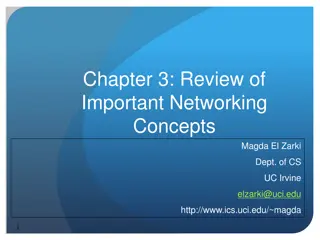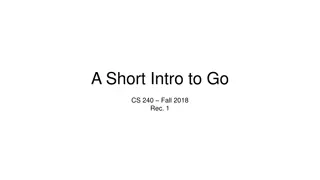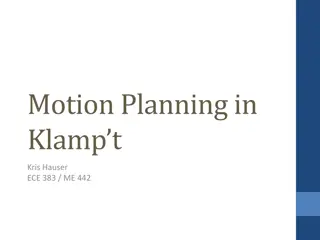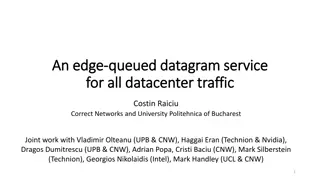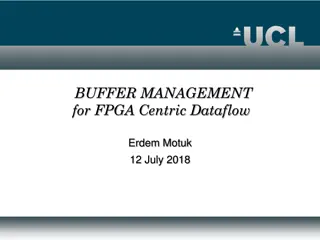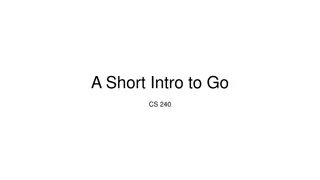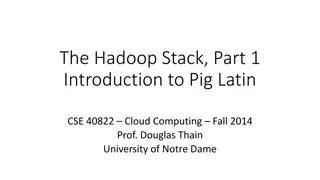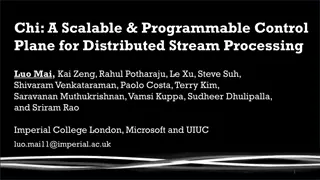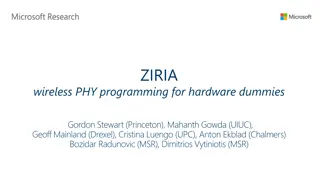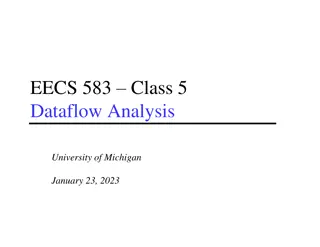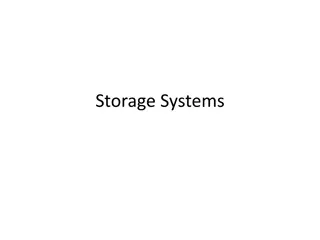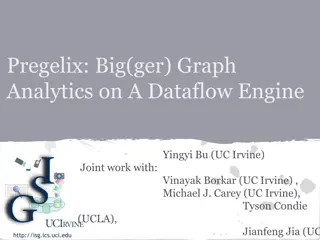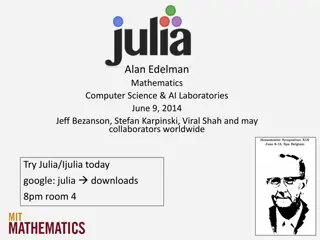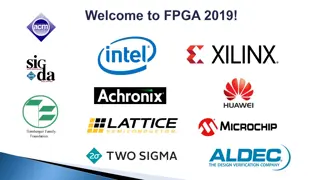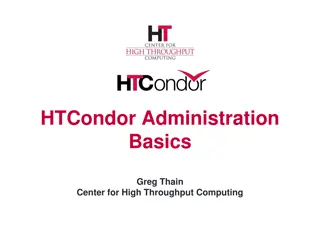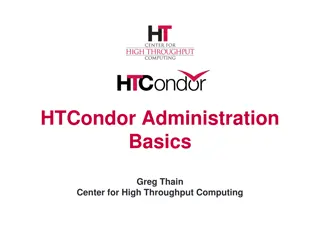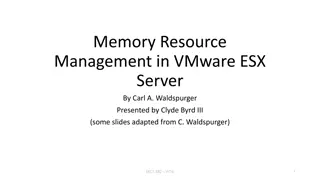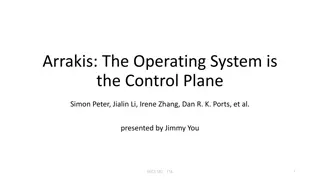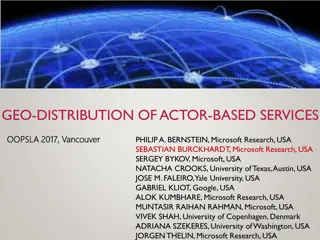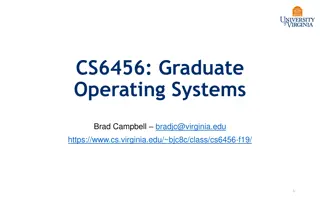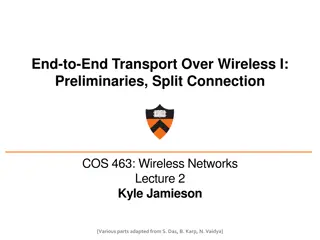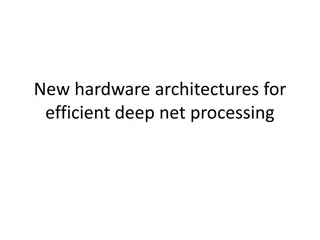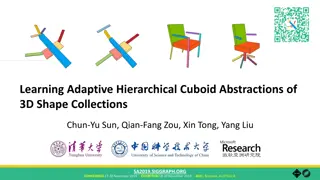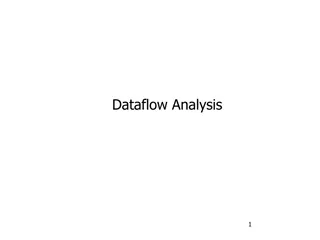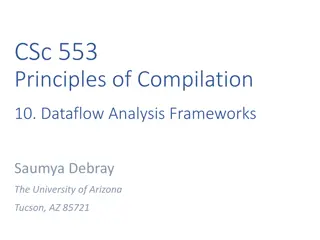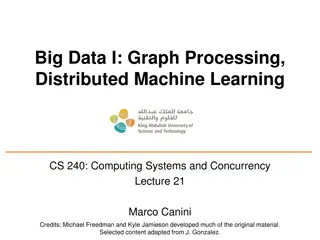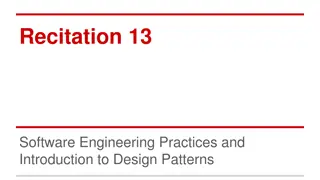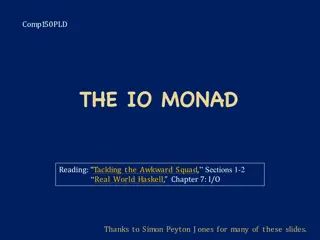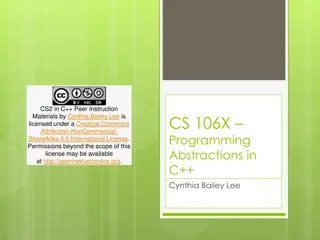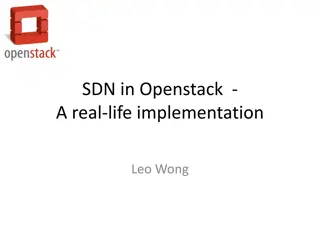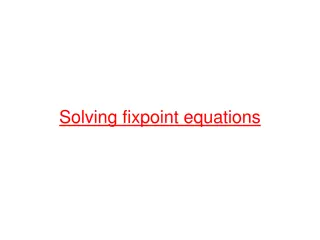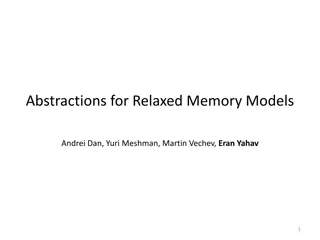Static Analysis Techniques Overview
Explore static analysis techniques such as syntactic analysis, dataflow analysis, and model checking. Understand the concept of basic blocks in static analysis and their boundaries. Dive into the opportunities provided by static analysis in summarizing program behavior without executing it.
9 views • 27 slides
Important Networking Concepts Overview
Review essential networking concepts including protocol architecture, protocol layers, encapsulation, network abstractions, communication architecture, and TCP/IP protocol suite. Understand the functions of different layers in networking for reliable data transfer and communication efficiency.
3 views • 43 slides
An Introduction to Go Programming Language
Go (Golang) is a compiled, concurrent, statically typed, and garbage-collected language developed by Google. It offers efficiency with good abstractions, easy multi-threading, and IO communication. Many companies choose Go for its speed and efficiency, transitioning from languages like Python due to
0 views • 17 slides
Motion Planning in Klamp't: Overview and Key Concepts
Motion Planning in Klamp't covers key concepts such as C-Space and robot-level abstractions, planning algorithms, toolkit components, and the kinematic planning pipeline. It compares to other packages like OMPL, MoveIt!, and OpenRAVE, offering PRM-style planners at the C-Space level and support for
0 views • 26 slides
Modern Datacenter Networking Technologies
Cutting-edge research in datacenter networking focusing on concepts like Edge-Queued Datagram Service (EQDS), TCP congestion control, network abstractions, and traffic handling mechanisms. Collaboration between prestigious institutions and experts to enhance network performance and efficiency.
0 views • 31 slides
Secure Computation Techniques in RAM Models with Efficient Automation
Explore the automation of efficient RAM-model secure computation techniques, including examples such as secure binary search. Discover how traditional solutions using circuit abstractions can be improved for sub-linear time computation through methods like Oblivious RAM. Learn about techniques such
0 views • 37 slides
FPGA Centric Dataflow Buffer Management Overview
This overview discusses buffer management for FPGA-centric dataflow systems, including the use of DDR4 RAM, solid-state storage, FIFO structures, and trigger commands for efficient data processing and storage. It also covers the handling of compressed and uncompressed data volumes, proposed hardware
0 views • 12 slides
The Norwegian Pilot Guide: Navigational Insights and Data Visualization
Explore the Norwegian Pilot Guide for sailing directions, featuring insights from the Hydrographic Service. Dive into dataflow, place names, and chart sources to enhance your maritime knowledge and navigation skills. Find a balance between data resolution and storage needs for offline usage with det
0 views • 29 slides
Introduction to Go Programming Language
Go (also known as Golang) is a compiled, concurrent, statically typed, and garbage-collected language developed at Google by Rob Pike in 2012. It combines efficiency with good abstractions, making it ideal for system development. Many companies have adopted Go for its ease of use, speed, and efficie
1 views • 25 slides
Introduction to Operating Systems and Processes
In this informative content, we delve into the fundamental concepts of operating systems (OS) and processes. Operating systems are essential software that manage a computer's resources for users and applications. We explore the core functionalities of an OS, such as resource allocation, isolation, c
0 views • 41 slides
Introduction to Pig Latin for Data Processing in Hadoop Stack
Pig Latin is a dataflow language and execution system that simplifies composing workflows of multiple Map-Reduce jobs. This system allows chaining together multiple Map-Reduce runs with compact statements akin to SQL, optimizing the order of operations for efficiency. Alongside Pig Latin, the Hadoop
0 views • 20 slides
Chi: A Scalable and Programmable Control Plane for Distributed Stream Processing
Distributed stream processing systems are increasingly crucial for various production use cases, such as real-time dashboards, machine learning, and interactive debugging. The challenges of handling large variability in production ingestion workloads and high-degree data skew in queries are addresse
1 views • 20 slides
Innovations in Wireless PHY Programming for Hardware
Programming software radios is a key aspect of wireless communication research, with recent advancements in PHY/MAC design and the use of SDR platforms like GNURadio and SORA for experimentation. Challenges include FPGA limitations and the need for hardware synthesis platforms like ZIRIA for high-le
0 views • 41 slides
Dataflow Analysis and Optimization in Compilers at University of Michigan
Explore dataflow analysis techniques and optimization methods in the context of compilers through the course EECS 583 at the University of Michigan. Learn about identifying optimization opportunities, common subexpression elimination, liveness analysis, and more to enhance program efficiency and per
0 views • 28 slides
Dataflow Analysis for Available Expressions in Compiler Construction
Utilizing dataflow analysis techniques, the concept of available expressions is discussed in the context of compiler construction. The goal is to identify common subexpressions that span basic blocks by calculating their availability at the beginning of each block. The process involves determining w
0 views • 59 slides
File Systems and Storage Devices in Computer Systems
Learn about the abstraction on top of physical storage devices, including magnetic disks and flash memory, and how file systems provide useful abstractions to manage and store data effectively. Explore the performance characteristics, crash tolerance, and access control features of file systems, as
0 views • 43 slides
Analyzing Big Graphs with Pregelix Dataflow Engine
Explore how Pregelix on a dataflow engine enables efficient processing of large graphs, providing insights on its system architecture, experimental results, and related work in graph analytics. Understand Pregel semantics, programming model, APIs, and graph mutations for effective analysis of big da
0 views • 38 slides
Object-Oriented Programming and Abstractions in Technical Computing
Delve into the realms of object-oriented programming, multi-methods, and abstractions in technical computing through various images and descriptions presented in the content. Discover the intersection of mathematics, computer science, and AI labs with a focus on Julia programming language and its ap
0 views • 10 slides
The Latest Trends in FPGA Technology and Applications
The ACM International Symposium on FPGAs brought together industry leaders and academia to discuss the rapid growth of FPGA technology in fields like machine learning, circuit design, and computing architectures. With insightful sessions, keynotes, and panels, the symposium highlighted the increased
0 views • 13 slides
HTCondor Administration Basics and Architecture
Explore the basics of HTCondor administration, architecture overview, setting up personal and distributed Condor systems, key abstractions, job and machine life cycles, and interactions between submit and execute sides. Learn about the components like condor_schedd, condor_shadow, and how jobs are p
0 views • 88 slides
HTCondor Administration Basics
Explore the fundamentals of HTCondor administration, including architecture overview, job and machine lifecycle, submit and execute sides, setting up personal and distributed Condor, and interactions with schedd. Dive into the HTCondor universe, job execution abstractions, and configuration nightmar
0 views • 92 slides
Memory Resource Management in VMware ESX Server Overview
This presentation discusses the background of memory resource management in VMware ESX Server, focusing on server consolidation, memory abstractions, and memory reclamation techniques. It covers topics such as page sharing, memory allocation policies, and related work in the field. The use of VMware
0 views • 26 slides
Vertex-Centric Programming for Graph Neural Networks
Seastar presents a vertex-centric programming approach for Graph Neural Networks, showcasing better performance in graph analytic tasks compared to traditional methods. The research introduces the SEAStar computation pattern and discusses GNN programming abstractions, execution, and limitations. Dee
0 views • 17 slides
Arrakis: The Operating System is the Control Plane
Arrakis is an innovative operating system that focuses on the control plane, designed to optimize performance in data centers by skipping the kernel for data-plane operations, retaining classical server OS features, and providing appropriate OS/hardware abstractions. It addresses slow system calls,
0 views • 30 slides
Actor-Based Services: Geo-Distribution Challenges and Solutions
Explore the complexities of geo-distributing actor-based services, handling multiple users, devices, data centers, and concurrent code execution. Delve into client app architecture, challenges of correctness under failures, and the quest for the right abstractions in composed services. Discover stra
0 views • 54 slides
Lessons in Network Reliability and Systems Design
Exploring the importance of end-to-end reliability in network communication, the examples highlight the pitfalls of assuming network perfection. From checksum failures in file copying to voting system flaws, the need for robust systems and user verification becomes evident. Emphasizing the challenge
0 views • 21 slides
Layering in Wireless Networks
This content delves into the concept of layering in wireless networks, highlighting the motivation behind layering, the Internet's approach to avoiding reimplementation for each underlying medium, the role of intermediate layers in providing abstractions, properties of network layers, and the functi
0 views • 53 slides
Efficient Hardware Architectures for Deep Neural Network Processing
Discover new hardware architectures designed for efficient deep neural network processing, including SCNN accelerators for compressed-sparse Convolutional Neural Networks. Learn about convolution operations, memory size versus access energy, dataflow decisions for reuse, and Planar Tiled-Input Stati
0 views • 23 slides
Innovative 3D Shape Abstraction Research at SIGGRAPH 2019
Explore the cutting-edge research on adaptive hierarchical cuboid abstractions and 3D shape structures presented at SIGGRAPH 2019. The goal is to construct a good 3D abstraction for shapes, focusing on compactness, expressiveness, adaptiveness, and consistency.
0 views • 56 slides
Dataflow Analysis in Program Optimization
Dataflow analysis is crucial for optimizing programs by identifying opportunities for improvements like constant propagation and dead code elimination. This analysis involves modeling values of interest, formulating fixpoint equations, and solving them to enhance program efficiency. Concepts such as
0 views • 34 slides
Dataflow Analysis Frameworks in Compilation
Dataflow analysis plays a crucial role in compilation by computing dataflow facts within basic blocks, using transfer functions and merge operators for inter-block analysis. This process helps in achieving convergence iteratively to a fixpoint, ensuring soundness, precision, and efficiency in runtim
0 views • 53 slides
Distributed Machine Learning and Graph Processing Overview
Big Data encompasses vast amounts of data from sources like Flickr, Facebook, and YouTube, requiring efficient processing systems. This lecture explores the shift towards using high-level parallel abstractions, such as MapReduce and Hadoop, to design and implement Big Learning systems. Data-parallel
0 views • 61 slides
Best Practices in Software Engineering: Design Patterns and Code Clarity
Software development can be chaotic, but by focusing on code clarity, adopting bug-avoidance practices, utilizing design patterns, and employing good coding strategies, engineers can create maintainable and scalable code. Methods with clear purposes and wrapper methods for readability, along with th
0 views • 37 slides
Tackling the Awkward Squad in Functional Programming
Functional programming is known for its beauty in concise abstractions and high-order functions, but it often struggles with managing the "Awkward Squad" of input/output, imperative state, and error handling. The Direct Approach involves dealing with side effects and imperatives directly but can lea
0 views • 43 slides
C++ Programming Abstractions: Peer Instruction for Java Programmers
Explore C++ concepts from a Java programmer's perspective, emphasizing good design principles like decomposition and readability. Delve into coding examples, such as clearing a chess board for a Queen safety program, discussing off-by-one errors, pass by reference feature, and decision making betwee
0 views • 15 slides
SDN and OpenStack in Cloud Computing
SDN in OpenStack enables innovation, accelerates new features and services, and simplifies provisioning. OpenStack is an open-source cloud software collection with tenant-facing APIs for consuming cloud services. OpenStack services include Compute, Block Storage, Object Storage, Images, and Network
0 views • 14 slides
Fixpoint Equations in Programming Languages
Fixpoint equations play a crucial role in programming languages for solving mutually recursive problems like parsing and dataflow analysis. This content explores the concepts of fixpoint equations, assumptions for ensuring solutions, computing solutions, and generalizations for cases with greatest e
0 views • 31 slides
Abstractions for Relaxed Memory Models
This content delves into abstractions for relaxed memory models, discussing verification under such models, changing programs for P.M.S, examples like efficient synchronization with barriers, and the placement of synchronization barriers in a Boids simulation. It also explores Dekker's Algorithm as
0 views • 66 slides

